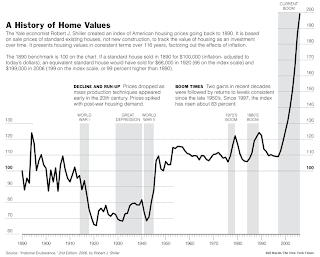The ominous clouds that have been lurking on the horizon have yet to materialize in the darkest forecasts imaginable, and the repeated commitment of the government to bail out the financial institutions at the crux of these issues makes me start to wonder if maybe we will be able to avert disaster through psychology, inflation, or some other means.
Someone with a contrary view is Nouriel Roubini of New York University’s Stern School of Business, who suggests that we are on a 12-step course to what he calls “The Mother of All Meltdowns” which he discusses in this article: America’s economy risks the mother of all meltdowns
Here are the 12 steps:
Step one is the worst housing recession in US history. House prices will, he says, fall by 20 to 30 per cent from their peak, which would wipe out between $4,000bn and $6,000bn in household wealth. Ten million households will end up with negative equity and so with a huge incentive to put the house keys in the post and depart for greener fields. Many more home-builders will be bankrupted.
Step two would be further losses, beyond the $250bn-$300bn now estimated, for subprime mortgages. About 60 per cent of all mortgage origination between 2005 and 2007 had “reckless or toxic features”, argues Prof Roubini. Goldman Sachs estimates mortgage losses at $400bn. But if home prices fell by more than 20 per cent, losses would be bigger. That would further impair the banks’ ability to offer credit.
Step three would be big losses on unsecured consumer debt: credit cards, auto loans, student loans and so forth. The “credit crunch” would then spread from mortgages to a wide range of consumer credit.
Step four would be the downgrading of the monoline insurers, which do not deserve the AAA rating on which their business depends. A further $150bn writedown of asset-backed securities would then ensue.
Step five would be the meltdown of the commercial property market, while step six would be bankruptcy of a large regional or national bank.
Step seven would be big losses on reckless leveraged buy-outs. Hundreds of billions of dollars of such loans are now stuck on the balance sheets of financial institutions.
Step eight would be a wave of corporate defaults. On average, US companies are in decent shape, but a “fat tail” of companies has low profitability and heavy debt. Such defaults would spread losses in “credit default swaps”, which insure such debt. The losses could be $250bn. Some insurers might go bankrupt.
Step nine would be a meltdown in the “shadow financial system”. Dealing with the distress of hedge funds, special investment vehicles and so forth will be made more difficult by the fact that they have no direct access to lending from central banks.
Step 10 would be a further collapse in stock prices. Failures of hedge funds, margin calls and shorting could lead to cascading falls in prices.
Step 11 would be a drying-up of liquidity in a range of financial markets, including interbank and money markets. Behind this would be a jump in concerns about solvency.
Step 12 would be “a vicious circle of losses, capital reduction, credit contraction, forced liquidation and fire sales of assets at below fundamental prices”.
For me…once we get to step 9 or so, the connections between the dots start to become hazy. Although the “shadow” financial system is indeed a bit scary in some senses, it is unclear to me that there will be a fundamental collapse in said system barring some direct event. I am not saying that such a collapse is impossible; it is just such broad generalizations seem to come from the fear of the unknown more than anything else.
I guess what I am saying is that given the level of consciousness that is being brought to bear on the other major challenges that we face, that perhaps through collective innovation, or pure financial sacrifice, we may finally be able to stop the bleeding and carnage.
